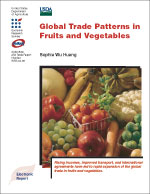Global Trade Patterns in Fruits and Vegetables
by
Sophia Huang,
Linda Calvin, William T. Coyle,
John Dyck, Kenzo Ito, David Kelch, Gary Lucier,
Agnes Perez, Susan Pollack, Shirley Pryor,
Anita Regmi,
Mathew Shane, Dennis Shields, Jim Stout, and Thomas Worth
Outlook No. (WRS-0406) 88 pp, June 2004
 International trade in fruits and vegetables has expanded at a higher rate than trade in other agricultural commodities, particularly since the 1980s. Not only has world trade in fruits and vegetables gained prominence, but the variety of commodities has expanded. Over the years, three regions—the European Union (EU), the North American Free Trade Agreement (NAFTA) area, and Asia (East, Southeast, and South)—have remained as both the major destinations and sources of supply. A substantial share of their trade is intraregional, particularly that of the EU. All the three regions, however, depend on Southern Hemisphere countries for imports of juices and off-season fresh fruits, and on equatorial regions for bananas, the leading fresh fruit import. In addition to global north-south trading, due mostly to the counter-cyclical seasons of the two hemispheres, Asian trade has also become much more important since the 1980s as incomes and populations have grown and policies changed.
International trade in fruits and vegetables has expanded at a higher rate than trade in other agricultural commodities, particularly since the 1980s. Not only has world trade in fruits and vegetables gained prominence, but the variety of commodities has expanded. Over the years, three regions—the European Union (EU), the North American Free Trade Agreement (NAFTA) area, and Asia (East, Southeast, and South)—have remained as both the major destinations and sources of supply. A substantial share of their trade is intraregional, particularly that of the EU. All the three regions, however, depend on Southern Hemisphere countries for imports of juices and off-season fresh fruits, and on equatorial regions for bananas, the leading fresh fruit import. In addition to global north-south trading, due mostly to the counter-cyclical seasons of the two hemispheres, Asian trade has also become much more important since the 1980s as incomes and populations have grown and policies changed.
Keywords: European Union (EU), North American Free Trade Agreement (NAFTA), Asia, United States, Canada, Mexico, Japan, China, Southern Hemisphere, Northern Hemisphere, bananas, fruits, vegetables
In this publication...
- Abstract, Acknowledgments, Contents,
 102 kb
102 kb
- Summary,
 49 kb
49 kb
- Introduction,
 67 kb
67 kb
- An Overview of Global Trade Patterns in Fruits and Vegetables,
 111 kb
111 kb
- Basic Determinants of Global Trade in Fruits and Vegetables,
 113 kb
113 kb
- The Role of the European Union in Fruit and Vegetable Trade,
 110 kb
110 kb
- NAFTA Trade in Fruits and Vegetables,
 341 kb
341 kb
- China’s Fruit and Vegetable Trade,
 155 kb
155 kb
- Japan’s Fruit and Vegetable Market,
 170 kb
170 kb
- Conclusions and Prospects for the Future of Fruit and Vegetable Trade,
 52 kb
52 kb
- References,
 147 kb
147 kb
- Entire report,
 908 kb
908 kb
Need help with PDFs?
Order this Publication